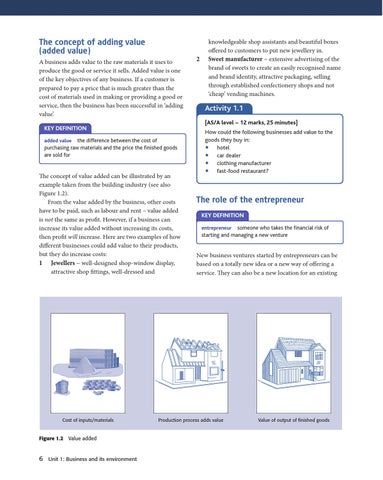The concept of adding value (added value) A business adds value to the raw materials it uses to produce the good or service it sells. Added value is one of the key objectives of any business. If a customer is prepared to pay a price that is much greater than the cost of materials used in making or providing a good or service, then the business has been successful in ‘adding value’.
the difference between the cost of purchasing raw materials and the price the finished goods are sold for
added value
The concept of value added can be illustrated by an example taken from the building industry (see also Figure 1.2). From the value added by the business, other costs have to be paid, such as labour and rent – value added is not the same as profit. However, if a business can increase its value added without increasing its costs, then profit will increase. Here are two examples of how different businesses could add value to their products, but they do increase costs: 1 Jewellers − well-designed shop-window display, attractive shop fittings, well-dressed and
Figure 1.2 Value added
6 Unit 1: Business and its environment
Activity 1.1 [AS/A level − 12 marks, 25 minutes]
KEY DEFINITION
Cost of inputs/materials
2
knowledgeable shop assistants and beautiful boxes offered to customers to put new jewellery in. Sweet manufacturer − extensive advertising of the brand of sweets to create an easily recognised name and brand identity, attractive packaging, selling through established confectionery shops and not ‘cheap’ vending machines.
How could the following businesses add value to the goods they buy in: hotel car dealer clothing manufacturer fast-food restaurant?
• • • •
The role of the entrepreneur KEY DEFINITION entrepreneur someone who takes the financial risk of starting and managing a new venture
New business ventures started by entrepreneurs can be based on a totally new idea or a new way of offering a service. They can also be a new location for an existing
Production process adds value
Value of output of finished goods
